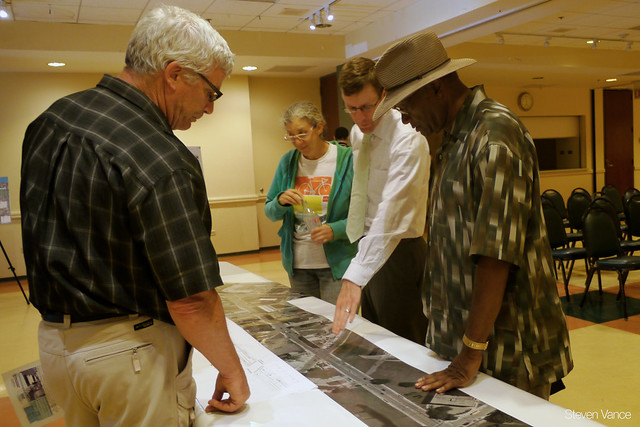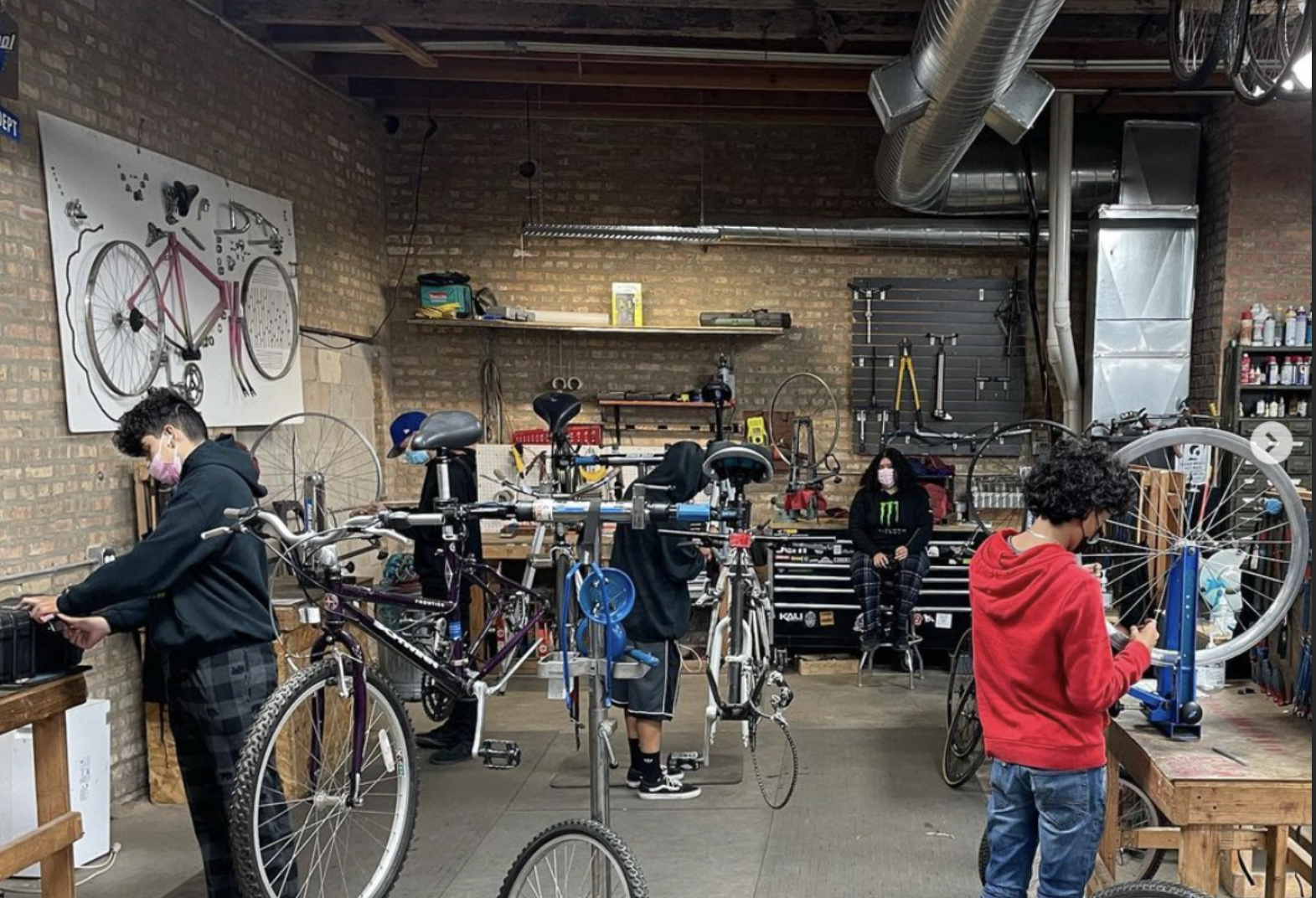CDOT Proposes Chicago’s First Curb-Separated Bike Lane On Clybourn
5:03 PM CDT on July 25, 2014
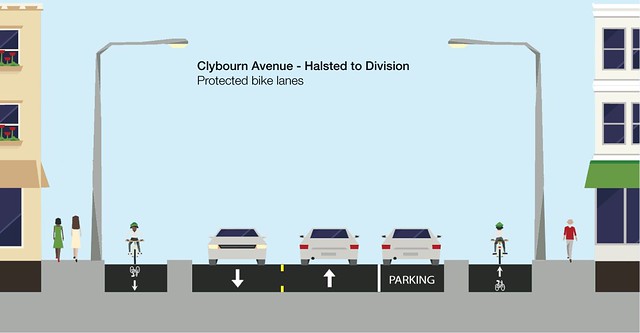
The Chicago Department of Transportation presented a proposal last night to build curb-separated bike lanes on each side of Clybourn, from Halsted to Division Streets, and to reconfigure the oversized intersection where Clybourn meets Division, Sedgwick, and Orleans in front of Seward Park.
CDOT bikeways engineer and project manager Nate Roseberry explained that Clybourn is part of the Illinois Department of Transportation's ongoing protected bike lanes feasibility study, which will test many elements of the design. Its goals, he said, are to reduce crashes, increase options for how people get around, and evaluate new design features. Those features include two infrastructure features new to Chicago: a curb separating the bike lanes from the auto travel lanes, which at three feet wide will also provide an opportunity for rain gardens; and a bus stop island, where bicyclists will go up and behind the bus stop.
Roseberry said that the proposal "was by no means complete," and that he wanted to listen to feedback from a group of keen and curious neighbors. Many people who bike through the area also gave their input.
27th Ward Alderman Burnett kicked off the meeting by saying the "state is allowing the city to propose" the first protected bike lane on a state route. In 2011, IDOT banned protected bike lanes on state routes, preventing CDOT from extending the Jackson protected bike lane where the street comes under state jurisdiction, east of Ogden Avenue.
Burnett said the proposal is intended to "stop the danger of bikes and cars from running into each other." He recalled that the death of 26-year-old Bobby Cann, who was bicycling on Clybourn at Larrabee, "enhanced the conversation" about safety on the street.
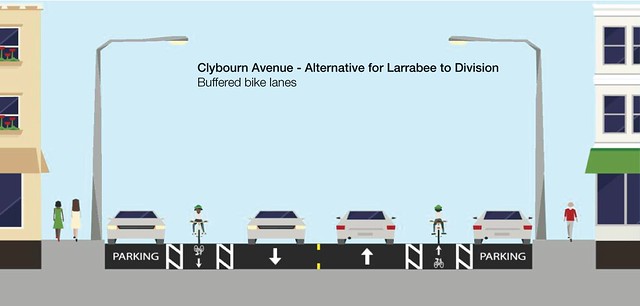
Burnett prefaced the meeting with his own concerns, particularly that parking is a challenge during the daytime for teachers and health clinic workers. He added that CDOT was finding places around the area to add street parking where it previously wasn’t allowed. He also said that, since there are a lot of bicyclists and a lot of car drivers in the community, "let’s make [CDOT] work to satisfy us" with the final design. CDOT data showed low parking utilization between the short commercial corridor southeast of Larrabee and the residential area northwest of Larrabee. They also found unused car parking available on side streets.
Roseberry described an alternative proposal for Clybourn, from Larrabee to Division, that would stripe a buffered bike lane in each direction. It would have the advantage, he said, of removing far fewer parking spaces. The disadvantage, he said, was that it wouldn’t eliminate the dooring hazard, unlike the curb-protected bike lane. Doorings made up 18 percent of reported bike-car crashes in Chicago in 2012.
Another part of the project, which would be funded by IDOT, includes a complete overhaul of the lane markings at the Clybourn-Division circus. New traffic signals for bicyclists would be installed on Division -- for westbound bicyclists at Clybourn and eastbound bicyclists at Orleans. The westbound signal would have a push button for through-bicyclists. Roseberry said that bicyclist-specific traffic signals lead to better compliance, saying that bike signals on Dearborn increased compliance from 31 percent to 90 percent.
CDOT is proposing to change Clybourn in other ways, like eliminating left turns from Clybourn onto Larrabee, which is done at a "counterintuitive," acute angle, Roseberry said.
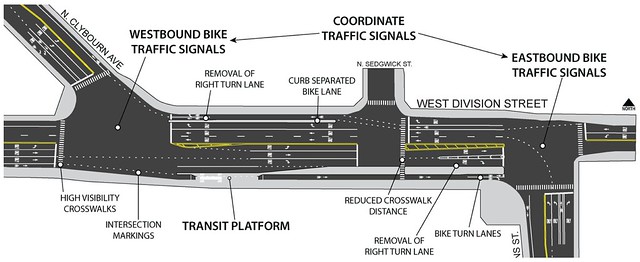
Roseberry mentioned that traffic counts conducted by the design team, which also included John Baczek and Pam Broviak from IDOT, showed that bicyclists made up 10 percent of morning rush hour traffic, adding up to over 300 cyclists during some peak periods. Despite this heavy bike traffic, CDOT is not proposing any bikeways for the short block of Clybourn between North Avenue and Halsted, past the Apple Store. Roseberry cited the need to manage "traffic queues" at that intersection.
Two attendees were concerned about future vehicle traffic conditions, which they assumed would increase due to the New City mall and residential complex currently under construction, and other new developments.
Mike Amsden, the assistant director of transportation planning at CDOT, said this plan was "forward thinking because of the growth in bicycle transportation." Alderman Burnett added that a new Brown Line station at Division and Orleans, just east of the site, is being "contemplated" as part of the Cabrini-Green redevelopment plan. Too much car traffic should be a good reason to invest in more space-efficient modes, like transit and bicycling.
The improvements to Clybourn, however, are primarily between the street's existing curbs. Another attendee said that she sees elderly residents of the Flannery Apartments who are unable to ride electric scooters on Clybourn's sidewalks, because of their poor condition. Roseberry said that this project excludes sidewalk fixes. He described other improvements for pedestrians, namely that all crosswalks would be upgraded to the "high visibility" zebra style, the crosswalk over Division at Sedgwick would be shortened, and improved crossing times.
Asked whether CDOT preferred either of the two proposals – the protected bike lane all the way from Halsted to Division, or cutting it short from Halsted to Larrabee – Amsden said, "we'd really like to see a barrier through all of it." Roseberry concluded that construction could begin in spring 2015. He invited the public to send comments to cdotnews@cityofchicago.org.
Explore the designs in our gallery, or download the presentation and tell us what you think in the comments.
Stay in touch
Sign up for our free newsletter
More from Streetsblog Chicago
It’s electric! New Divvy stations will be able to charge docked e-bikes, scooters when they’re connected to the power grid
The new stations are supposed to be easier to use and more environmentally friendly than old-school stations.
Today’s Headlines for Tuesday, April 23
Communities United: Reports of Bikes N’ Roses’ death have been greatly exaggerated
According to the nonprofit shop's parent organization, BNR has paused its retail component, but is still doing after-school programming and looking for new staff.
